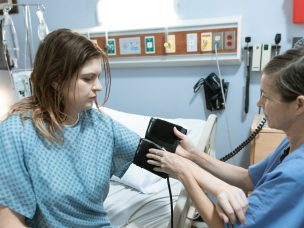OBGYN & Women’s Health
The Present and Future of Menopausal Vasomotor Symptoms and Treatment
Review of the current treatments and future perspectives for vasomotor symptoms during menopause. Vasomotor symptoms (VMS) affect approximately 80% of menopausal women worldwide. Characterized by hot flashes and night sweats, the symptoms range in severity and can affect quality of life. A study in the International Journal of Women’s Health reviewed hormonal and non-hormonal treatments...
Efficacy and Safety of Fezolinetant for Menopausal Vasomotor Symptoms
Fezolinetant is efficacious and well-tolerated for treating moderate to severe vasomotor symptoms associated with menopause. Vasomotor symptoms (VMS), characterized by hot flashes and night sweats, affect most women during menopause. Hormone therapy is effective for managing VMS. However, it may not be appropriate for some women, depending on underlying medical conditions and risk factors, age,...
Obesity Heightens Fracture Risk in Postmenopausal Women
According to a new meta-analysis, obesity increases the risk of all-cause and vertebral fractures in postmenopausal women while potentially serving as a protective factor against pelvic fractures. These results highlight the importance of weight management in mitigating fracture risks among this population. Obesity correlates with a higher risk of all-cause fractures, including vertebral fractures in...
Maternal Cytokines Linked to Risk of Gestational Diabetes
Inflammatory cytokines, leptin, tumor necrosis factor-α, and interleukin-6 may be key to understanding the development of gestational diabetes mellitus, according to a recent systematic review and meta-analysis. The systematic review and meta-analysis included 24 studies, providing an in-depth look at the relationship between leptin, TNF-α, IL-6, and the risk of gestational diabetes. Findings show that...
Automation Bias ID'd for Radiologists of All Levels of Experience
Automation bias seen for radiologists reading mammograms with aid of artificial intelligence system. Radiologists with all levels of experience reading mammograms are prone to automation bias when supported with an artificial intelligence (AI) system, according to a study published online May 2 in Radiology. Thomas Dratsch, M.D., Ph.D., from the University of Cologne in Germany, and...
Pre-Eclampsia Risk Factors in Women With High-Risk Pregnancies Taking Aspirin
Women pregnant with twins or with a previous diagnosis of pre-eclampsia or high blood pressure may benefit less from aspirin than those with other issues such as body mass index greater than 35 or insulin resistance. Pre-eclampsia (PE) affects 2.1–5.6% of pregnancies and is the second leading cause of maternal mortality worldwide. In addition to...
Patient Characteristics Modify Effectiveness of Mailed Human Papillomavirus Screening Kits
Increased screening uptake is observed with mailed self-sampling kits by all sub-groups. Differences in effectiveness according to patient characteristics highlight opportunities to optimize self-sampling for priority groups. Human papillomavirus (HPV)-only is a cervical cancer screening method that is more sensitive than Papanicolaou (Pap) cytology-based testing. It has the further advantage of allowing individuals to collect...
Cost-Effectiveness of Human Papillomavirus Self-Sampling Kits for Screening Cervical Cancer
Mailing human papillomavirus self-sampling kits to eligible women is a cost-effective method to improve screening rates for cervical cancer in the US healthcare system. Cervical cancer is largely preventable through early screening for precancerous changes caused by human papillomavirus (HPV). The currently available method for HPV-only (primary HPV screening) is more sensitive than the standard...
Psychological Effects of Early Pre-Eclampsia Screening
Despite temporary depressive symptoms, pregnant women showed good attitudes toward the first 12 weeks of pre-eclampsia screening. Pre-eclampsia (PE) affects 2–5% of pregnancies and is a major cause of maternal and fetal morbidity and death, accounting for 12% of all maternal fatalities worldwide. However, the most successful diagnostic strategy for PE in the early stages...
More Medical News














